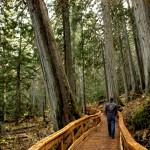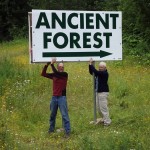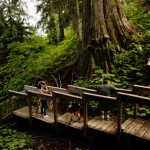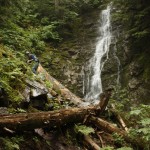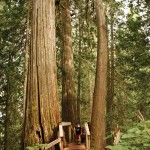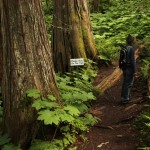By: Korie Marshall
The Regional District is supporting the Caledonia Ramblers hiking club’s goal to have the Ancient Forest designated as a World Heritage Site. The first step is to achieve provincial park designation for the area, and the club is hoping to meet with Minister of Environment within the next few weeks.
The Ancient Forest is a unique inland wet-temperate rainforest located about an hour from either McBride or Prince George, near the Slim Creek rest stop on Highway 16. It boasts trees that are 1,000 years old, and possibly as old as 2,000. A research paper by Darwyn Coxson and David Donnell of UNBC and Trevor Goward of UBC says ancient cedar stands within BC’s inland rainforest are unique not only in BC but globally. The size and age of western red cedars, so far from the ocean is remarkable in itself, and the stands in the upper Fraser valley support a variety of canopy lichens, including some that appear to be unique to the area.
The paper says inland rainforests have been recently identified in other parts of the world, but only in BC are large portions of them still intact. Some of the ancient cedar stands in the upper Fraser are currently protected in old-growth management areas. But there are few cedar stands in provincial parks, either because the parks are above the elevation limits of red cedar, or the area was logged before being designated as a park. Slim Creek Provincial Park is an exception, as it contains several small but significant ancient cedar stands, but most of the park is other forest types.
In the paper, Coxson et al argue the stands could and should be designated as a UNESCO World Heritage site. They say the majority of the world’s remnant old-growth wet-temperate rainforests are now protected, and many have been designated as World Heritage Sites. One example is the Gondwana Rainforests of Australia, a network of dispersed remnant stands, and the paper says they are similar to what we have today in the upper Fraser watershed – the authors argue the same criteria could be demonstrated here. They say designation has been a turning point in recognizing the scientific value of these stands, but it has also supported the economic diversification of these regions, and they believe the same potential exists in the upper Fraser River watershed.
Coxson says he and David King, a director of the Caledonia Ramblers, made a short presentation to the Regional District Board on behalf of the Ramblers about the proposal, which was published in the BC Journal of Ecosystem and Management. Coxson says they had not asked for a letter of support, but certainly appreciate the endorsement of the directors, and are willing to describe the proposal to any interested parties. The area is public lands, and Coxson says he understands the various provincial ministries are reviewing emerging scientific data in this field to incorporate it into their management plans.
“The passion and commitment of people in communities across the region in building and supporting the Ancient Forest Trail site is a real grass roots success story,” says Coxson. “I suspect that even today there will be people carrying donated lumber down the trail, and working on maintaining the boardwalk and other facilities.”
King says indeed they were – on Thursday Oct. 2nd, 10 people were volunteering their time to continue improving the main trail. The universal boardwalk, allowing people with mobility issues to use the trail, was completed last summer, and now the group is working on installing planks over the entire trail.
Nowell Senior, president of the Caledonia Ramblers, says the planks make the trail more safe and user friendly for visitors. But they also protect the ground and the roots of the trees, because people don’t have to step around wet spots, widening the trail, and they don’t scuff and wear at the ground and roots. It is a win-win.
Senior says the Ramblers have been encouraged to continue with trying to make the area a provincial park, because of the support they’ve heard from industry, First Nations, MLA Shirley Bond, the Ministry of Forests, and there has been no big barriers so far. There is no protocol for making a new provincial park in BC right now, says Senior, but the Ministry of Environment is developing one. He says they hope to meet with Mary Polak, Minister of Environment in the next few weeks, but they have no idea how long the process to designate a new provincial park might take.
Senior says over $340,000 worth of materials, in kind contributions and volunteer labour were donated to Ancient Forest Trail projects by 80 sponsors and supporters between 2005 and 2014, including support from the McBride Community Forest Corporation other McBride businesses. He says other research by David Connell shows that visits to the Ancient Forest have generated $250,000 in spinoffs for the region, which is both significant and sustainable. Trail counters were malfunctioning last year, but it is estimated the trail received 15,000 visitors in 2013, and preliminary data from this year shows that number has already visited the trail in 2014.
King says while working on the trail last week a German couple came by, their third visit to the trail in five years. They said their first visit was an accident, but a highlight of their trip, and it is now a priority stop on their trips to Canada.
Three options for expanding Slim Creek Provincial Park are proposed, the largest covering approximately 16,000 hectares along Highway 16. All three include the Ancient Forest Trail and part of Driscoll Ridge. The two larger options also include the upslope forests along Driscoll Ridge, presumed to be important to maintaining the hydrological processes required to maintain ancient cedar stands.



